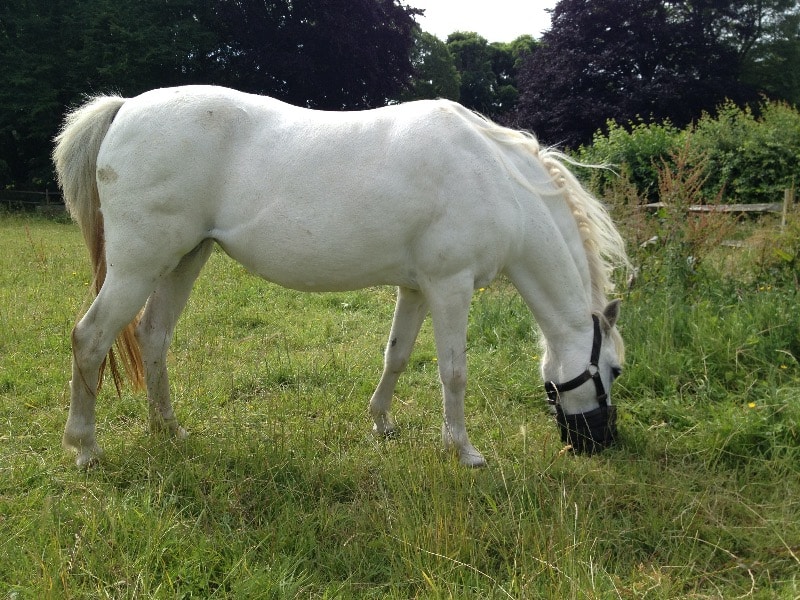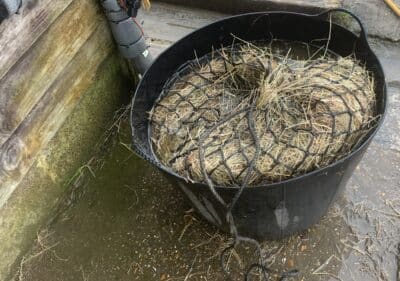Appetite & Feeding, Featured, Nutrition
How to help your horse lose weight safely
The Horse Hub asked Katie Grimwood MSc, nutritionist at Baileys Horse Feeds, how we can help our horses to lose weight safely
By definition, ‘good-doers’ are horses or ponies that maintain and hold their weight easily but, this is really an endearing way of describing those who are overweight. Sadly, fat horses are widely accepted as ‘the norm’ – even though obesity is associated with conditions such as insulin dysfunction (a risk factor for laminitis), orthopaedic disease, infertility and poor performance.
Objective assessment
Objective assessment on whether your horse needs to lose weight is hard when you look at him every day so, every 2 weeks:
- Take photographs
- Body condition score (BCS)
- Weigh tape
This will help you to monitor weight and fat accumulation. Horses or ponies with a BCS of 6-7 (using the Henneke 9-point system) are considered overweight and, those with a BCS of 8 or 9 are obese.
It’s not rocket science – if there is no veterinary underlying reason for weight gain it is likely a combination of over-feeding and insufficient exercise, although genetics do factor. Many breeds are adapted to thrive on poor grazing and programmed to put on weight when food is plentiful – spring and summer – so when combined with abundant supplementary feed and forage, the weight goes on.
If your horse has been identified as needing to lose weight, ensuring fewer calories are consumed than expended can be tough – and it’s particularly tough if you are a horse – an animal designed to spend most of its life eating!
Controlling calorie intake – forage and grazing
Aim for 0.5% reduction in bodyweight per week, so 2.5kg loss a week for an obese 500kg horse. Make restrictions gradually – the first step is to check what you are currently feeding and how much.
Restricting forage
Sometimes it is necessary to restrict forage intake, as even though ‘ad lib’ provision is ideal it can be a huge contributor of calories so, any restriction must be done sensibly, with no long periods without access to forage. Likewise, access to grass is ideal but, will most likely need to be limited for good doers, particularly during the key growing periods of spring and autumn, when calories and nutrients are highest.
Strip grazing, track systems and grazing muzzles can be effective in reducing grass intake, while providing exercise but, may have varied results. Read how to fit a grazing muzzle correctly here.

Restricting turnout time may not be effective – it has been shown that horses on reduced turnout compensate by consuming grass sometimes up to three times faster than those out for longer periods! Therefore, in some cases, removing them from grass altogether during high-risk periods may be the best solution – however, you must ensure adequate access to regular forage, exercise and relief from boredom.
Why is measuring dry matter important?
- No less than 1.5% of bodyweight – absolute minimum – should be provided as forage/fibre per day, on a dry matter basis, this equates to 7.5kg for a 500kg horse.
- Because hay typically has a water/moisture content of around 15%, this means you must feed around 9kg per day (7.5kg + 15%).
- If you’re feeding haylage – typically around 35% water content – 11.5kg per day would be the minimum requirement.
- Late harvest hay or haylage is best for weight loss – it has higher proportion of stalk and stem compared to leaf so contains fewer calories and nutrients and is less digestible.
Soaking hay
Soaking hay reduces its calorie content by “washing out” water soluble carbohydrates (WSCs). When beginning to feed soaked hay, always increase the soaking time gradually so your horse can get used to the different taste. Their digestive system needs adapt to the increased moisture intake. You can also mix soaked hay with dry hay initially, for fussier feeders.

Studies have shown that around 8 hours is the optimum soak time for the removal of WSCs (calories). Soaking for longer, does not result in the removal of significantly more WSCs. Hay should always be soaked out of direct sunlight in fresh, clean water every time. Drain it in a cool, dry area again out of direct sunlight, to minimise the risk of moulding. Soaking haylage is not always advisable.
If you are restricted to only feeding haylage, say for respiratory disorders or this is the only forage provided by your yard, you can replace a proportion of haylage with good clean straw or a low-calorie chaff. Straw provides fewer calories than hay and haylage and, can be useful to help supply fibre and bulk while lowering calorie intake. Ideally no more than 30% of the forage portion should be fed as straw per day. Again, straw should be introduced gradually to help avoid digestive disturbances.
Monitor water intake to ensure your horse is drinking enough.
Tips to make a restricted forage ration last longer
- Using small-holed nets or double netting will encourage trickle feeding and keep horses chewing for as long as possible, while also limiting forage intake.
- Placing nets around the stable or paddock can help to encourage increased movement and slower eating.
- Fibre blocks may be fed to replace some of the hay ration – these are tightly compressed, so it can take the horse longer to eat.
- Adding soaked hay to a feed ball (making sure it has had time to drain beforehand) can slow down their eating speed.
- Feed small amounts of soaked unmolassed sugar beet in a separate bucket. This provides more volume, while providing very few calories and helps to fill your horse up.
Controlling calorie intake – bucket feed
Even the best quality forage is often lacking in certain key nutrients, and soaking hay can leach out nutrients as well as calories. A balanced diet is important for all horses to support overall health and well-being, including a healthy metabolism for weight loss, good energy levels, and muscle tone and top line.
While feeding a ‘token’ amount of a low energy, high fibre mix or cube is not high in calories, these feeds are formulated to be fed by the scoop – eg. a 500kg horse at rest or in light work would need 1½ – 2 Stubbs scoops a day – any less means it will not get all the necessary vitamins and minerals.
So, a pelleted forage balancer can be a better option as it provides vitamins, minerals, and quality protein, with negligible calories and, is fed very small amounts – a 500kg horse in light work would need just 500g per day. Feeding a balancer all year round means your horse is getting all the essential nutrients, while you control their energy (calorie) intake according to workload and time of year.
Exercise
Just like us, to achieve weight loss your horse’s exercise should be increased alongside the change in diet. Daily low to moderate intensity exercise can be helpful whereas, light exercise only 3-4 times a week is less likely to have any effect on bodyweight.
However, any exercise programme needs to be realistic for the individual horse and certainly, some exercise is better than none at all – a gradual increase in exercise is ideal.
For unridden horses or ponies try lunging, long reining, walking in hand and plenty of turnout on a bare or sand paddock, with small haynets and water buckets placed on opposite sides.
Putting it all together
Finding the right balance for your good doer is key to keeping them healthy as well as slim. Weight loss will take time and you may not notice an immediate difference on the weightape – your horse may be losing internal fat that is not obvious externally.
Consistently weighing feed, increasing exercise and monitoring progress will pay off.
If you are doing all the above and still struggling, speak to a nutritionist or your vet for some extra pointers.
Why choose Baileys?
Baileys Horse Feeds is still family-owned and run with many of those involved being hands-on horse owners, who feed the feeds and care about how they work, for their own and their customers’ horses. They are also backed by expert nutritional knowledge and understand the practical challenges faced by today’s busy riders.
All the ingredients in Baileys’ feeds are of the highest possible quality and chosen to bring real nutritional benefits, while being sourced and produced with conscious efforts to reduce their impact on the environment.
Working to a strict code of feed safety, feeds are also monitored for the presence of specified naturally occurring prohibited substances so are the choice for top competition and racehorses as well as the family pony.
Read more about nutrition here
